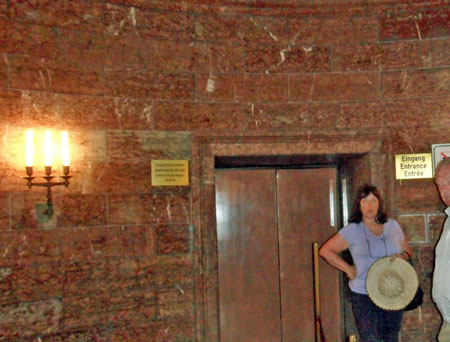
A place of great beauty, in which a residence was built for the devil reincarnated, Adolf Hitler. Situated upon a mountain top in the Alps, at an elevation of 6,017 feet above sea level, it has breath taking views of the mountains and valleys below. Since then, the idyllic setting and remarkable architecture of the Eagle’s Nest on the Kehlstein have been overshadowed by its close connection with the Third Reich. Although Hitler rarely stayed in the building himself, his wicked tyrannical image still hangs over it today.
httpv://www.youtube.com/watch?v=nrHYUlWNm1k
Given this background, it is not surprising that a plan to demolish the Eagle’s Nest was very nearly approved in the 1960s. Just as Hitler’s command centre on the Obersalzberg had been destroyed by the bombs of the liberating Allied forces, so, it was hoped, would the Eagle’s Nest be wiped forever off the face of the beautiful Bavarian landscape. As it turned out, however, history took a different course, and the building has been administered by the Berchtesgaden Regional Tourist Office since 1960. Today, the Eagle’s Nest is leased out to private operators who run it as an alpine restaurant. The engineering feats and mighty architecture of the building leave many visitors speechless. Even the approach from the carpark is imposing: a tunnel of 124 metres in length, lined with panels of natural rock, runs through the mountain massif. At the end of the tunnel there is a grandiosely designed brass-plated lift. The lift ascends to the interior of the Eagle’s Nest in just forty-one seconds. Inside, visitors are surrounded by metre-thick walls and mighty bulwarks. At 1,834 metres above sea level, the Eagle’s Nest commands a breathtaking panoramic view.
The Kehlsteinhaus was commissioned by Martin Bormann, with construction proceeding over a 13-month period. It was completed in the summer of 1938, prior to its formal presentation to Hitler on his 50th birthday on April 20, 1939. It is situated on a ridge at the top of the Kehlstein Mountain 1,834 m (6,017 ft), reached by a 6.5 km (4.0 mi) long and 4 m (13 ft) wide road that cost 30 million RMs to build (about 150 million euros in 2007, adjusted in line with inflation). It includes five tunnels but only one hairpin turn and climbs 800 m (2,600 ft).
The last 124 m (407 ft) up to the Kehlsteinhaus are reached by an elevator bored straight down through the mountain and linked via a tunnel through the granite below that is 124 m (407 ft) long. The inside of the large elevator car is surfaced with polished brass, Venetian mirrors and green leather (the elevator is still used daily). Construction of the mountain elevator system cost the lives of 12 construction workers.The main reception room is dominated by a fireplace of red Italian marble, presented by Mussolini. Much of the furniture was designed by Paul László.
The Eagle´s Nest itself and the unique Kehlstein road were constructed in an extremely short period of time despite the difficulties of wartime: the fortress-like residence took one year to build, the Kehlstein road thirteen months. The unique design of the road has no counterpart anywhere in the world. It makes no more than a single bend in its ascent of the towering 700 metres between the Obersalzberg and the Kehlstein carpark, traversing the steep north-west face of the Kehlstein twice as it does so. The road is now closed to normal traffic; it can only be accessed by a bus service.
It is interesting to know why the structure is built in the peculiar manner it is; meaning the unusual/impractical tunnel to elevator entrance.
Psychoanalysts have long speculated that the structure symbolically represented Hitler’s mother; this is paired with the theory that Hitler’s hatred of anything not-German originated as a direct result of being within earshot of the frequent and rambunctious sex acts between his mother and step-father, the Austrian merchant whom would plague Hitler’s psyche as having defiled of his mother as well as having stolen her away from him.
The Eagle’s nest was meant as a retreat for a man having regressed past the emotional stage of infant. Hitlers use of the structure as a retreat during times when the leader was most distressed as well as his activities at the site reinforce this theory.
The entrance tunnel was considered symbolic of the womb. Not just because of it’s location in the structure but also due to many design elements such as it’s oval shape, gentle upward slope and it’s expensive, yet functionally useless bronze decoration.
The Eagle’s Nest is described as being “exactly what one would design if they explicitly wanted a building to function as a suragette womb.
The elevator is considered as functionally useless due to it’s relatively minor elevation gain that could have been more easily trans versed by automobile as well as it’s small ‘capsule-like’ elevator car which would function symbolically as an undoing of travel through the birth canal.
I have been here John…Everyone should see this.
Glad you had a great trip!~